Note: since this was published, Google has announced the end of MyTracks, and as a result Google Fit now tracks bike mileage, though without any other kind of stats.
We can’t escape it, we’re in the digital age. Companies are all about Data, and we as consumers have followed along. With the rise of GPS-enabled devices in phones and bike computers, almost anyone can now track their cycling and running statistics, complete with geolocation and tons of other stats. This of course allows us to not only track our ride history, it allows us to compare information and apply it different ways.
I’ve long been a fan of GPS technology, and so naturally I migrated to using GPS to track my bike rides and commuting miles. But there are so many choices out there! How’s a person to decide what’s best for them, except try them all? I even made a poll in the G+ Bike Commuter Cabal community!
Fear not, for I’ve already used them all*, and my findings are here to help you make a decision on which App is best for you and your riding style.
We’re going to look at the top ones, and also include Google’s newcomer “Google Fit” to the mix, just to see how it stacks up against apps that have been on the market for years. I started off using a 7″ Samsung Galaxy Tab, and recently got a Motorola Moto G, which is what I’m recording rides with now. All app data and screenshots are from the Moto G. The apps will be reviewed in the order I tried them, nothing special about that.
Criteria:
- App itself (quality, reliability, features, ease of use, accuracy)
- Accompanying website, features, ease of use
- File Formats import/export
- Paid features (if available)
- Score/uses/thoughts
*Caveats: As I’m not a competitive cyclist, and there’s not many other cyclists in my town, I haven’t been able to use a lot of the social features of these apps. Strava and Endomondo in particular have very strong social elements, so if you’re looking for that kind of interaction, I’d recommend looking at those first.
MapMyRide
I initially started cycling with MapMyRide. Back then the app was pretty simple, and the website was the best thing going. I eventually stopped using it because the app somehow didn’t work with the GPS on my tablet well… the track would jump all over the place. Out of fairness, I decided to fire it back up and try it again, to see how it had changed over the last couple of years.
App: The app itself is kind of visually cluttered now. There are ads everywhere, and buttons/popups to subscribe to their service, but it’s at least functional.
The app allows you to track multiple kinds of exercise, log your food and calorie intake, connect with friends, and make and share routes. It also does audio voice prompts for each mile, and supports ANT+ and BT4 sensors. The free version doesn’t do coaching or training, though. And it doesn’t come with a widget to monitor or start/stop rides. It does have the capability to connect with Google Fit and MyFitnessPal to share data. It even has a “Nutrition” app that lets you track your diet. The audio feedback settings were impressive, though; it can prompt on time or distance, and include any of the data it tracks.
I tried to find information on whether it would work with Android Wear/Gear watches, but they don’t seem to be officially supporting them yet.
Website: The website is just as busy as the app. It allows you to do challenges, social interaction, set goals, make routes, and view your statistics. Here’s a screencap of the default workout view:
There’s some good basic info there, though there wasn’t much else to see. The sharing options don’t require special privileges, and you can edit before posting it on social apps.
File Formats: MMR natively imports from numerous device websites, including Garmin. It also imports .TCX, .GPX, .FIT and .HRM files. The free version doesn’t allow you to export workouts.
Paid Features: If you go “MVP” (cost is $30/yr or $6/mo) then it removes ads from the app, and adds the following features:
- Power, Cadence, and Heart Rate Analysis
- Printed Maps
- Training Plans and Mobile Coaching
- “Live Tracking” (lets you update your workout location and status in real time)
- Exporting Workouts
- In-App Camera
- Custom Splits, Advanced Leaderboards
- Advanced Maps
Thoughts: Considering that it does work pretty well, I wasn’t that impressed with the app’s features. I thought the free version should probably come with a few more options enabled. However, it does work and track well, and only took two touches to start a ride. The food tracking part was pretty cool, too.
Rating: Free version gets a 6/10, slightly above average.
Endomondo
When I switched, I checked out Endomondo next. The app was pretty simple, and it had some nice features. It also worked well with the GPS receiver on my tablet. They offer two ways to upgrade your experience: the “Pro” app, and the subscription Premium service. When they rolled out the Pro app with some new features, I thought it was a good idea, and paid a few dollars for it. Then a few months later, they initiated the “subscription” portion, and locked down some of the features unless you forked out money every month. I eventually ended up dumping Endomondo as well, because of the app’s Feature Creep.
On a high note, it includes many of the features you have to pay for in MapMyRide like Live Feed, Interval coach, export, statistics, and photo tagging. It does include two widgets for your phone, but they’re for social feed or workout stats… no start/stop function. With the newest version (not the Pro version, only the Premium/Free) it should work with Android Wear watches.
App: The mobile app has some nice features. It has the ability to connect with Facebook, Twitter, Google, and MyFitnessPal accounts, to share data and accomplishments. The audio feedback is also configurable, like MapMyRide, but also includes an interval coach feature. It also has a built-in music player shortcut. It really just launches the app… but it keeps a playlist of what you listened to while you ride. It also supports the usual ANT+ and BT4 sensors. They also (after 2 years of people asking) included support for USB ANT+ dongles… which means you can use cheaper ANT+ sensors and a USB OTG cable for your phone along with a Suunto ANT+ dongle. Awesome option for older or cheaper phones that don’t have ANT+ built-in. I’ve been using this one the longest, and I’m pretty familiar with it. It looks like this:
Website: The site is pretty decent to use. There’s a lot of stuff cluttering the feed, like constant challenges and messages. It’s mostly social interaction, really. There’s a small chunk of stats on the left, and a small bit of info on the right. The rest is social feed. The sharing options don’t give you the ability to modify what it posts.
Here’s a screencap of the workout summary screen:
Basic info, with some options to share and export. It’s laid out pretty well, no ads or junk here.
File Formats: Endomondo exports as .TCX or .GPX, and imports as .TCX, .GPX, and .FIT
Paid Features: Endomondo PRO is the older, paid version of the Endomondo Free app. (NOTE: it’s a one-time purchase, costs $5) In the PRO app there are no ads, and you have access to these extra features:
- Interval Training
- Beat Yourself
- Time Goal
- Calorie Goal
- Graphs
- Low Power Mode
- Audio Settings
- Step Counter
The Subscription Premium version (for $30/yr or $4/mo) adds these features over the Pro version:
- Tag Statistics
- Workout Comparison
- Training Analysis
- Benchmarking against friends
- Weather Stats
Thoughts: I’m kind of torn on this one. The Pro app is well worth the $5, but it’s been End-Of-Lifed. I felt pretty mad when they stopped development on Pro and switched to a subscription model, which offered very little over the version I had already paid for. The app itself (at least the Pro version) is very nice, if a bit too heavy on the social stuff. But it does work, and has a lot of features.
Score: I’ll give it a 8/10 for the Pro version, 6/10 for the free version.
MyTracks
I’ve been using MyTracks for a while, for simplicity’s sake. It tracks activity with GPS, has support for external sensors, automatically syncs to the cloud (Google Drive) and has basic charts and data.
Website: The “website” is really just Google Drive, with a folder where it stores all your files. You can “share” each file with a specific group, and you can view the track (without stats) in Google Maps. That’s about it. It stores the files natively as .KMZ files (developed for use with Google Earth). There is no option to export or convert to other formats in Google Drive; these functions are done entirely by the Mobile app.
The real beauty of Google’s solution is that you can export all your rides to a Google Docs spreadsheet, and then use Google Tables to graph, filter, and compare any and all of your data, including sensor input, for free. If you’re a math nerd or stats hound, this allows you to manipulate your graphs and results in a way that other services can’t touch. It’s not plug-n-play, though… you have to do it yourself. Here’s a sampling of what you can do that I whipped up in a few minutes.
Spreadsheet:
Pivot Table with Chart:
App: This is actually pretty good. If I had to choose based solely on the mobile app, MyTracks would take it hands down. It has a lot of features, plus widgets for the desktop and lock screens. It can be integrated into automated program routines with Tasker (on Android). It’s compatible with ANT+ and Bluetooth sensors, and smart watches (with third-party apps) including Android Wear (with native support). Some features:
- It can embed GPS-enabled photos and notes into recordings, which are then searchable by location.
- It has the capability to play back recordings with a Google Earth plugin.
- You can view tracks with slower/faster areas highlighted within a certain percentage of your average speed.
- It has an auto-resume feature that resumes a workout if your phone reboots.
- It has independent audio prompts and GPS waypoints for segments based on time or distance, from 1 minute/1 mile to 60 mins/100 miles.
File Formats: MyTracks can export in .KML, .GPX, .CSV, and .TCX but only from the mobile app. It can also import .KML and .GPX files. It can also export directly to a spreadsheet in Google Drive.
Thoughts: If you don’t actually need social interaction within the app itself, then MyTracks is a very solid, powerful alternative. Lots of features that are based on the actual data, ease of use, and the option of third-party extensions that improve it even more.
Rating: 9/10 for the App itself, 7/10 overall for lack of additional social media services.
GoogleFit
Google Fit is a relative newcomer to the Fitness App world, but it’s made by Google, so they know a thing or two about it. This is the app for people who don’t need all the bells and whistles, and just want to have very basic, simple indicators of how much they exercised.
Website: After a usual day’s commute for me, the website shows up like this (the 2 blue bars in the morning are because I paused at a stoplight):
There’s not a lot of information there, but it does keep track of walking, running and cycling. It does this completely automatically, without any need for starting or stopping the app. There’s also an option to sync activities with Google MyTracks,
App: There’s not much to it, really. It shows you elapsed time for each activity, and what time of day they happened. It also lets you add heartrate and weight charts to track long-term. It lets you set goals, and notifies you when you reach them. The default goal is 1 hour of walking a day. It should natively work with Android smart watches, including heart rate monitors. You can view your exercise times, number of steps taken, and even track your heart rate and weight with a graph.
File Formats: There aren’t any, since it doesn’t actually track mileage.
Thoughts: This is kind of a neat indicator of how much time you’ve spent exercising, but it can’t be used for tracking miles, and none of the data can be exported. It’s a nice addition to MyTracks, but on its own, there’s really no point other than the automatic tracking.
Rating: I think Google Fit is good for someone just starting out with an exercise routine, and just needs a daily indicator of how they’re doing. Not much appeal to it otherwise. 4/10
Strava
I hadn’t actually used Strava up to this point, as it seemed the only thing it was good for was competing for KOM’s, and I don’t care zippy-zap about competing, so I never bothered. For posterity, I sucked it up and made a Strava account. Just for you, my dedicated readers.
App: The app was pretty good. Same basic stuff, but it adds stats on things called “Segments.” If you’re familiar with Strava, you know these are short routes that you can “compete” on, and they can be fun if lots of people (or even that one guy) shares the segment. You can also use the map to find other segments, and see what the records on them are. I also thought it was interesting that you have to “slide to unlock” the app to stop it recording.
It also has a Start/Stop/Stats widget for the phone desktop, which is very nice, but not for the lock screen. The app has the capability to connect with other services, like Google Fit, Instagram, and MyFitnessPal to sync and share data. There are a few third-party apps for it as well, that let you bulk upload data and do a few other things. It lacks good audio prompts, however, except for Segment results (i.e. stats on your current Segment, not on time or distance).
Strava DOES NOT work with the Gear Fit, but works with the Gear 2 and Android Wear.
Website: I didn’t find the website was particularly easy to use, but it wasn’t bad, either. A lot of options were presented that you could only access as a Premium user, but you don’t find that out until you click on it and it hits you with a sales pitch (this is pretty much the same as all the others).
It also has a “Gear” feature that lets you track mileage on multiple bikes, which is nice if you change drivetrain parts based on mileage, and have multiple bikes. Here’s the ride stat page, with all the standard charts and stuff:
File Formats: Strava natively imports from numerous device websites, including Garmin. It also imports .TCX, .GPX, and .FIT files. The free version allows you to export rides in .GPX format.
Paid Features: Premium membership costs $59/yr, $6/mo. Features include:
- “Suffer Score” tracking of heart rate
- Filtered Leaderboards (by weight/age)
- User Goals
- Power Analysis (also for Power Meters)
- GPX route downloads from other users
- Real-time segment tracking and notices
- Real-time friend activities
- “Trophy Case” for badges earned
- Various Premium-only perks, events, etc.
- Training Videos from The Sufferfest
Thoughts: I was actually impressed with Strava. It’s gotten so much bad press from “KOM” hounds that I really wasn’t interested in it initially. However, the actual app is pretty good, and the website has some unique features that aren’t available elsewhere. If there were an app that looked worth the money for paid features, Strava is a strong contender. However, it costs twice what Endomondo does. If you’re sold on the social aspect though, it could be well worth it.
Rating: Free version gets 5/10, the Paid version gets 8/10.
Ride With GPS
RideWithGPS was requested specifically, and I’d heard of it before, of course. I never really gave it a fair shake, and so I decided it was time to give a run, and see how it held up against the rest of the big hitters!
App: The app is pretty nice, actually. Very clean, not too much clutter. The “Start Ride” button is present almost everywhere, which I like!
It doesn’t have any widgets, though there may be some third-party apps that extend its functionality. It tracks fine, and I didn’t have any problems with it at all. That being said, it doesn’t have many extra features. It also takes a few seconds to load up, while most others load almost instantly (except Strava, it was slow to load as well).
One thing I noticed is that it has the ability to load pre-existing routes and cue sheets, which if you’re into Randonneuring, could be extremely helpful. It also has settings to notify you when a cue sheet has a turn coming up, and will turn the screen on and prompt you as well! If you have a handlebar mount for your device (or strap it on a handlebar bag), it works as a smart, digital GPS cue sheet. Pretty sweet.
Website: The website is pretty good, too. I was pleasantly surprised. It’s functional, simple, and even with the social functions, pretty easy to use. To be honest, it did everything right. It wasn’t amazing, wasn’t bad… I think it was just right. The layout was very different than the others and is visually distinctive, but it wasn’t hard to use at all. Pretty slick. It also allows you to play back your ride in the browser. You can upload GPS files from other apps to upload@rwgps.com and (if you used the same email you signed up with) it will automatically save and file it for you! Very slick indeed.
They offer two levels of paid membership. The first level is $6mo/$50yr, and offers:
- Plan Advanced Routes
- Track your Bike Maintenance
- Print Custom Cue Sheets
- Navigate & Live Log (in app)
The second level is $10mo/$80yr and offers:
- Clean-up Your Ride Data
- Customize Any Route
- Smart Sync your Garmin
- Create and Track Personal Segments
File Formats: Exports in .GPX, .KML, and TCX formats (for Garmin devices and such). Imports .GPX, .KML, .TCX, and .FIT files. All formats are available in the free version.
Thoughts: There’s a lot to like here, actually. I’m surprised RideWithGPS didn’t get more votes, as it’s a pretty good all-around solution. The app isn’t fantastic, but it covers the basics very well, and the website (in my experience) is very nice. I don’t see much advantage to getting the premium service, but then again, it depends on what your needs are. Definitely impressed with the free version, however. There are some really cool unique features, and a decent mobile app, so this service is pretty well rounded.
Rating: Free version is 7/10, paid version is 8/10.
In Conclusion:
After having used each of these, I can honestly say I didn’t get to try every single feature, even after 3+ weeks. There’s just so much there. However, if one of these looks like something you’d be interested in, you can always try them for free for yourself! Any one of them would work in a pinch to track mileage (except Google Fit) and everything on top of that is icing on the cake, as they say.
My next step is to probably get an ANT+ adapter for my phone, and a speed/cadence sensor, so I can track any time I spend on the trainer indoors, and also get an idea of my cadence patterns as they relate to speed and time. MyTracks will help me graph everything out, and maybe in a few months, I’ll be able to compare data and actually use it to improve my riding. For free options, MyTracks offers the best data manipulation and comparison, but at the cost of social media interaction.
All the apps (except Fit) will cover the most basic data recording: distance, speed, elevation, and sensor input. Where they shine is in the unique features, so for the TL;DR version, here’s a list of each app’s unique features (and shortcomings):
MapMyRide Pros: Food/calorie tracking Cons: Ads, free version needs more features
Endomondo Pros: Music player shortcut, interval coach, $5 Pro version Cons: Not very configurable
MyTracks Pros: Track playback, export to spreadsheets, Tasker integration Cons: No social media features
Google Fit Pros: Automatic activity detection Cons: Only the most basic tracking
Strava Pros: Real-time Segment stats, separate bike profiles Cons: Could use more non-social features, expensive
RideWithGPS Pros: Can pre-load turn-by-turn cue sheets for Rando or trails Cons: Not many advanced features
If you have any questions, comments, or observations, please let me know!


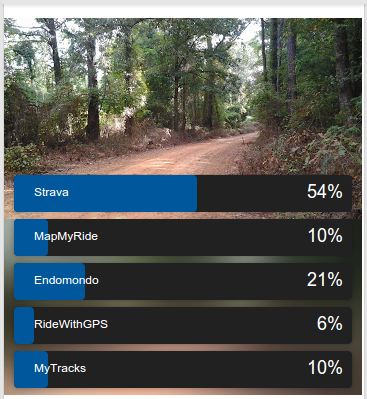
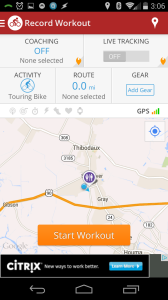

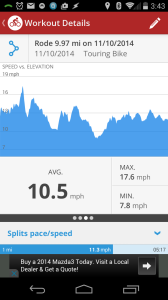
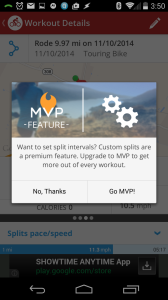
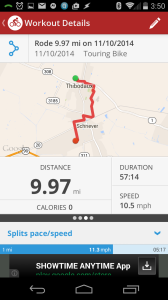
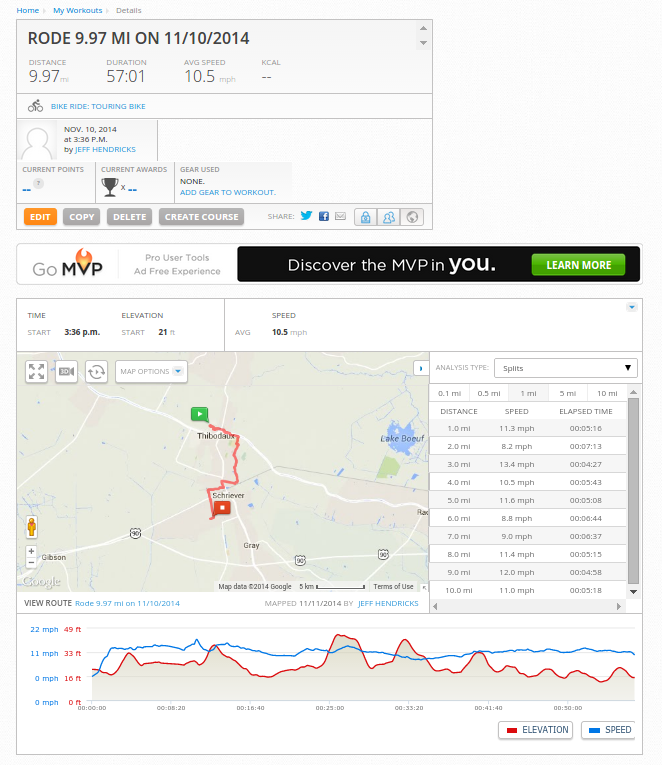

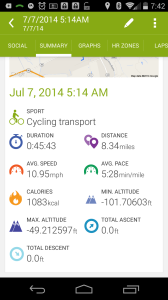
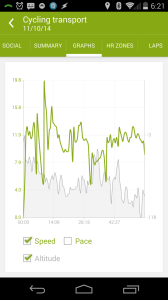
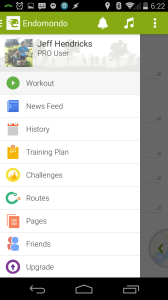
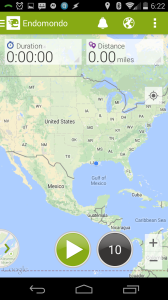
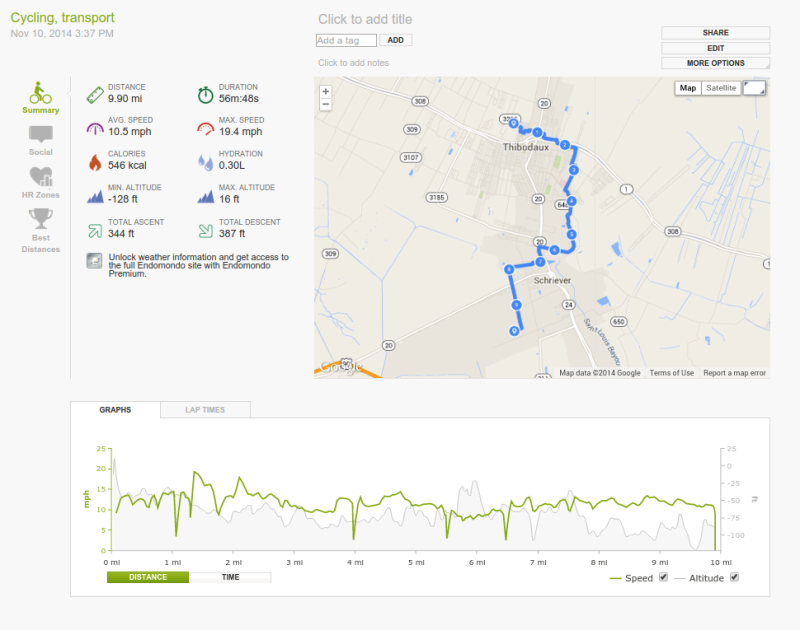
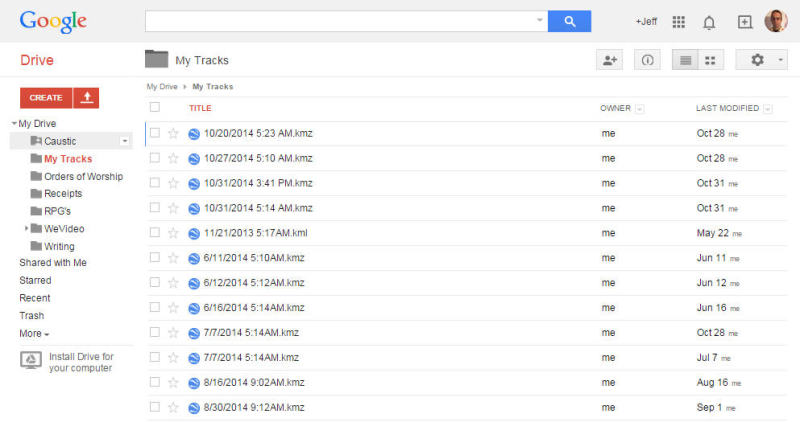
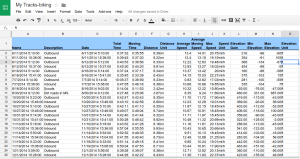
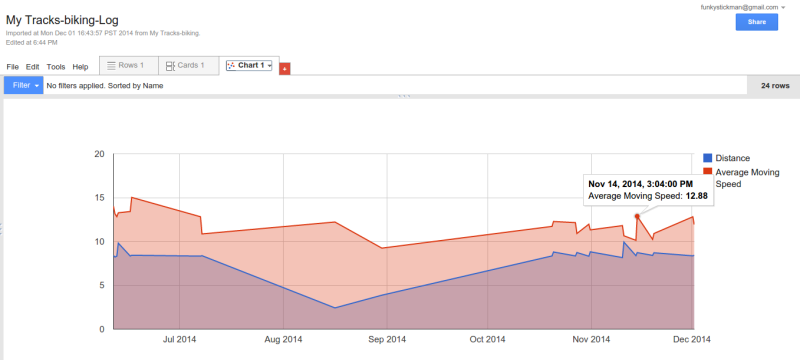
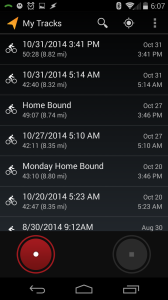
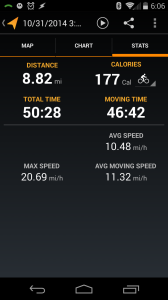

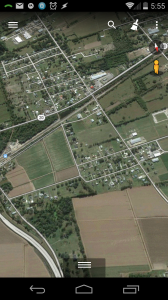
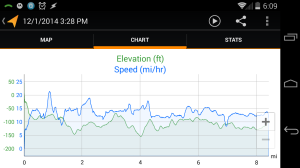
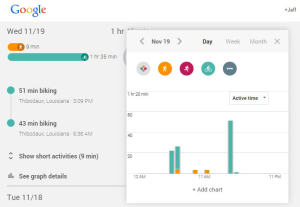
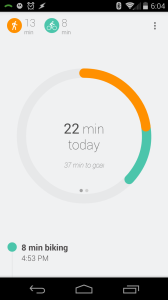
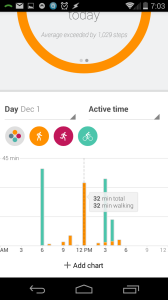
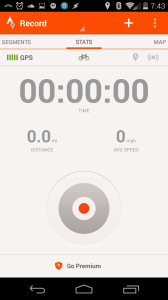
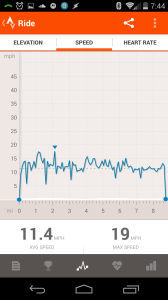
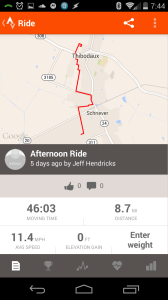
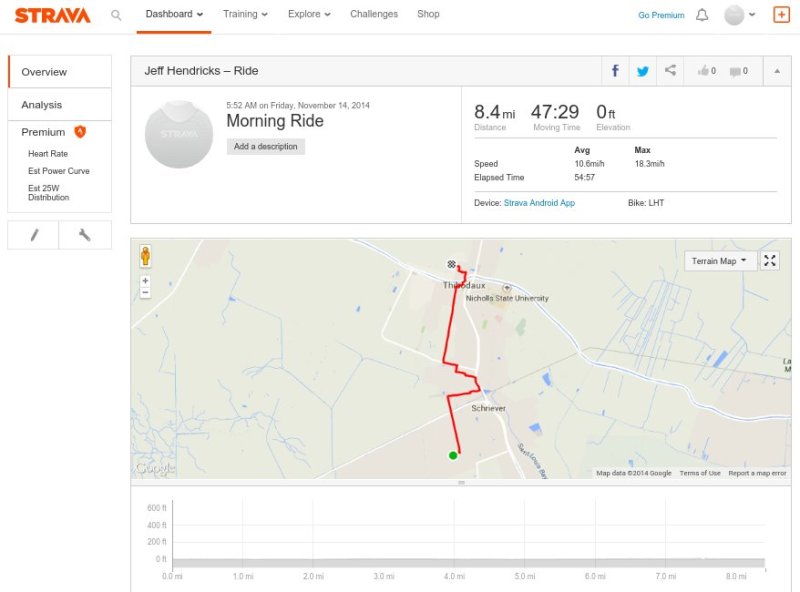
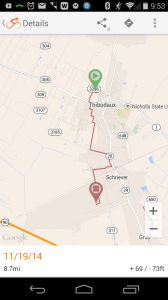
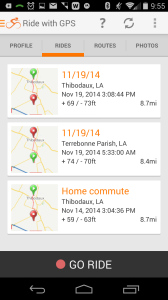
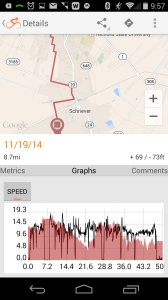
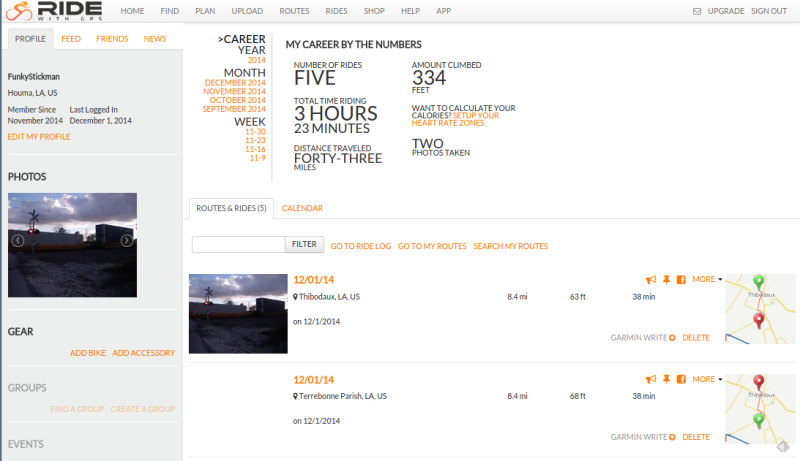
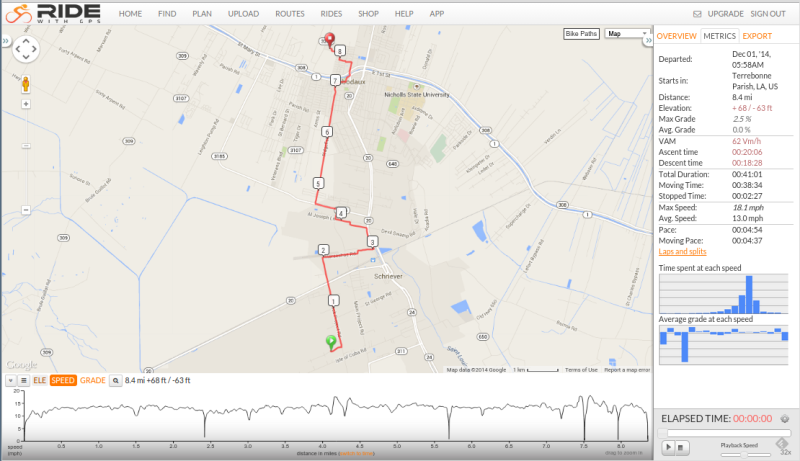
Hello! Useful apps, thanks for sharing! If you ever need a free converter to make GPS data format to kml files, I suggest trying http://gpx2kml.com/. It has a simple interface, allowing users to convert also kml to gpx format.